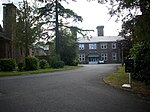Melrose Abbey

St Mary's Abbey, Melrose is a partly ruined monastery of the Cistercian order in Melrose, Roxburghshire, in the Scottish Borders. It was founded in 1136 by Cistercian monks at the request of King David I of Scotland and was the chief house of that order in the country until the Reformation. It was headed by the abbot or commendator of Melrose. Today the abbey is maintained by Historic Environment Scotland as a scheduled monument.The east end of the abbey was completed in 1146. Other buildings in the complex were added over the next 50 years. The abbey was built in the Gothic manner and in the form of a St. John's Cross. A considerable portion of the abbey is now in ruins. A structure dating from 1590 is maintained as a museum open to the public. Alexander II and other Scottish kings and nobles are buried at the abbey. A lead container believed to hold the embalmed heart of Robert the Bruce was found in 1921 below the Chapter House site; it was found again in a 1998 excavation and documented in records of his death. The rest of his body is buried in Dunfermline Abbey. The abbey is known for its many carved decorative details, including likenesses of saints, dragons, gargoyles and plants. On one of the abbey's stairways is an inscription by John Morow, a master mason, which says, Be halde to ye hende ("Keep in mind, the end, your salvation"). This has become the motto of the town of Melrose.
Excerpt from the Wikipedia article Melrose Abbey (License: CC BY-SA 3.0, Authors, Images).Melrose Abbey
Abbey Street,
Geographical coordinates (GPS) Address Nearby Places Show on map
Geographical coordinates (GPS)
| Latitude | Longitude |
|---|---|
| N 55.598888888889 ° | E -2.7177777777778 ° |
Address
Melrose Abbey
Abbey Street
TD6 9LG
Scotland, United Kingdom
Open on Google Maps










